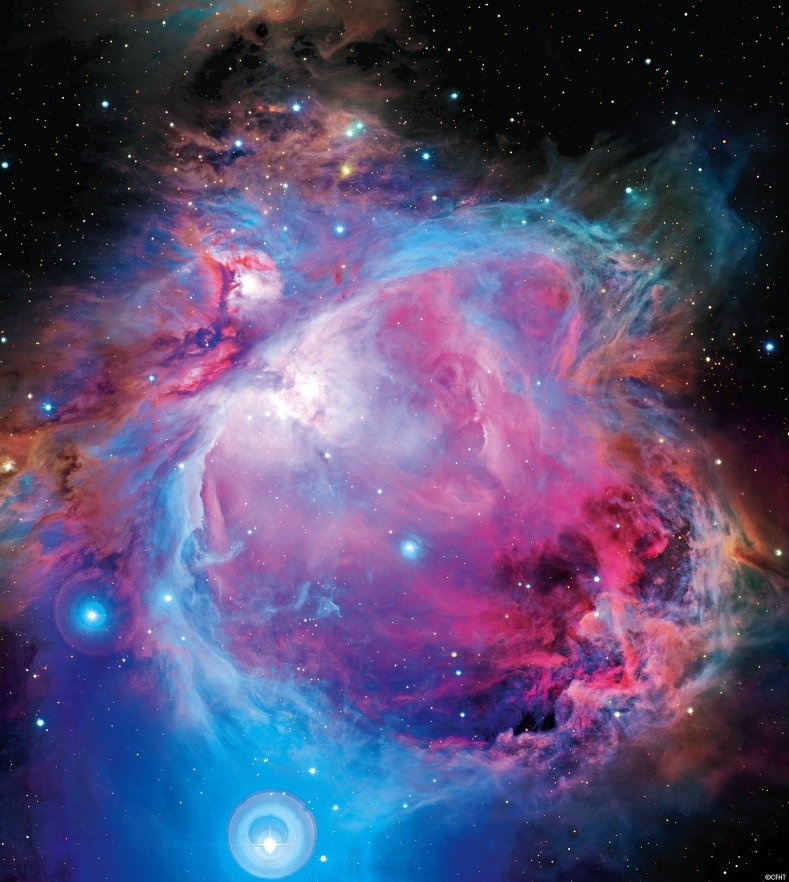Star Cluster Near Orion Nebula Revealed in Telescope Views

A star cluster once thought to be part of the spectacular Orion Nebula is actually a separate celestial entity parked in front of the nebula, a new study reveals.
Scientists using the Canada-France-Hawaii Telescope in Hawaii found that the star cluster NGC 1980 is a distinct, massive bunch of stars in front of the Orion nebula, which at a range of 1,500 light-years is Earth's closest known star factory. The cluster is huddled unevenly around the star iota Ori at the southern tip of the sword in the famed Orion constellation.
The star cluster is a slightly older sibling of the Trapezium cluster at the center of the Orion Nebula, the researchers say. And the findings suggest a cosmic structure that astronomers have been calling the Orion Nebula Cluster is actually a complicated mix of these two star clusters.
"For me the most intriguing part is that the older sibling, the iota Ori cluster, is so close to the younger cluster still forming stars inside the Orion nebula," study researcher João Alves, of the University of Vienna, said in a statement.
Alves and his colleagues combined observations of the Orion nebula by the MegaCam imager on the Canada-France-Hawaii Telescope with past studies using ground-based and space observatories to make the discovery. [Gallery: The Splendor of the Orion Nebula]
"It is hard to see how these new observations fit into any existing theoretical model of cluster formation, and that is exciting because it suggests we might be missing something fundamental," Alves added. "Clusters are very likely the favorite mode of star formation in the Universe, but we are still far from understanding why that is exactly."
Alves's colleague and co-author of the study, Hervé Bouy, of the European Space Astronomy Centre in Madrid, said follow-up studies are needed to unpack the secrets of these star clusters.
Get the Space.com Newsletter
Breaking space news, the latest updates on rocket launches, skywatching events and more!
"We must untangle these two mixed populations, star by star, if we are to understand the region, and star formation in clusters, and even the early stages of planet formation," Bouy said in a statement.
The imaging techniques used to study the newly identified cluster combined optical, infrared and mid-infrared data and helped ensure that only stars located in the foreground of the Orion Nebula were sampled, the researchers said. These methods also led the team to discover a small star cluster south of iota Ori, which has been named L1641W.
The research is detailed in the November 2012 issue of the Astronomy & Astrophysics journal.
Follow SPACE.com on Twitter @Spacedotcom. We're also on Facebook and Google+.
Join our Space Forums to keep talking space on the latest missions, night sky and more! And if you have a news tip, correction or comment, let us know at: community@space.com.

Space.com is the premier source of space exploration, innovation and astronomy news, chronicling (and celebrating) humanity's ongoing expansion across the final frontier. Originally founded in 1999, Space.com is, and always has been, the passion of writers and editors who are space fans and also trained journalists. Our current news team consists of Editor-in-Chief Tariq Malik; Editor Hanneke Weitering, Senior Space Writer Mike Wall; Senior Writer Meghan Bartels; Senior Writer Chelsea Gohd, Senior Writer Tereza Pultarova and Staff Writer Alexander Cox, focusing on e-commerce. Senior Producer Steve Spaleta oversees our space videos, with Diana Whitcroft as our Social Media Editor.